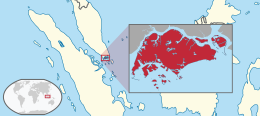I have not blogged about nuclear issues with respect to Singapore before. There is not much news about it. However, recently, there have been calls for Singapore to support discussions, debates and education about the possibilities and problems of nuclear power.
The Republic of Singapore is an independent city-state and island country in Southeast Asia. It is located at the southern tip of continental Asia and is just across the Straits of Johor from Malaysia. Singapore consists of a diamond shaped main island and a number of smaller islets. They have been engaging in land reclamation and have increased their area by over twenty percent since the 1960s. Currently, the size of Singapore is about two hundred and eighty square miles and it has about five and a half million residents.
The U.K. controlled Singapore from 1826 until 1963 when it was granted its independence in union with Malaysia. It was soon expelled from the union and experience political and social turbulence for years. It has no natural resources to speak of but it has become highly successful as a hub for Asian trade and financial transactions. It ranks high on lists of social indicators and is a popular city for business, conventions and meetings.
Ninety five percent of Singapore's electricity is generated by natural gas power plants. Natural is cleaner that oil or coal but it is still a fossil fuel that generates greenhouse gases. The cost of electricity in Singapore is about four times higher than average cost in the U.S. The reason for this higher cost is the fact that Singapore has to import all of its natural gas.
Supporters of nuclear power claim that if Singapore build nuclear reactors, they could substantially lower the cost of electricity for ratepayers. There is also international pressure for countries in the region to lower carbon emissions which nuclear power could play a part in reducing. There have been recent efforts to ramp up the production and use of solar power systems but critics point out that Singapore has limited land upon which to deploy such systems.
In 2010, Singapore started studying the benefits of adding nuclear power to its power generation. In 2012, the study was completed and the final conclusion was that the risks and cost of nuclear power outweighed the benefits for Singapore. The study pointed out that Singapore does not have the need for the amount of power generated by a single massive conventional nuclear reactors. They did look at new modular reactors designs that produced less power but none of these designs have actually be built and put into operation. Singapore did not want to be the first country to build and test the practicality of the new modular designs.
Another problem that Singapore considered was the need for an "exclusion" zone around a nuclear power plant in case of an accident. This was made abundantly clear by the aftermath of the Fukushima in Japan in March of 2011. Singapore is so small that a safe exclusion zone would be as big as the whole nation. In essence, in a major accident, the citizens would have to abandon their whole country. This is obviously a major reason for Singapore to reject the use of nuclear energy.
In spite of ruling out the use of nuclear power in Singapore, the government decided that it would be wise to acquire knowledge of nuclear science and sixty million dollars was set aside in 2014 for a five year Nuclear Safety Research and Education Program. Radiation measurement and nuclear medicine are two of the subjects that will be part of the program. Singapore may also collaborate with other South Asia countries that are planning on building nuclear reactors as part of their Education Program. This Education Program is a prudent action on the part of Singapore even though it will not use nuclear power.
Singapore:
